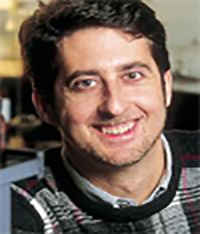
Chemistry Professor Naresh Dalal and Pat Hayward, former associate vice president for academic support.
It took four years of planning and another two-and-a-half years of construction, but the wait was well worth it: Florida State University is celebrating the grand opening of a new, state-of-the-art Chemical Sciences Laboratory that will offer expanded educational and research opportunities for decades of faculty members and students.
Located along Chieftan Way and overlooking the Scott Speicher Tennis Center on the campus’s west side, the 168,000-square-foot, five-story building was the site of a ribbon-cutting ceremony on Friday, May 2. FSU President T.K. Wetherell; Department of Chemistry and Biochemistry Chairman Joseph Schlenoff; and Nobel Laureate Harold Kroto, FSU’s Francis Eppes Professor of Chemistry, were among those on hand to christen the dawn of a new era for the university’s science community.
“Chemistry is well known as the ‘central science’: We bridge disciplines, foster collaborations and bring together scientists from other fields,” Schlenoff said. “A chemist could be laboring to understand the workings of a cell, or creating new medicines or innovative materials. Some of us try to understand atomic nuclei, and others look at distant galaxies, searching for the spectroscopic signatures of certain elements or molecules.

“Supporting such diverse interests requires a robust laboratory, capable of hosting current and yet-to-be imagined experiments,” Schlenoff said. “This building was designed with input by a broad group of chemists to support ground-breaking molecular sciences. Our instruments are as versatile as our people, covering the widest range of the electromagnetic spectrum, from radio waves to X-rays, and our gathering spaces provide pleasant surroundings for faculty and students to get excited about science. This building truly represents the state of the art in chemistry research facilities and is a great example of what academics, administrators and other professionals can achieve when they share a vision of excellence.”
The $72-million building will house some 250 researchers and will considerably expand research capabilities and programs in the molecular sciences. FSU administrators acknowledged the excellent research and scholarly activities of the university’s chemistry faculty, some of which led to significant patent royalties that helped to make the building possible.
The composition of the Chemical Sciences Laboratory is as follows:
- The first floor will host core research facilities and a lecture hall capable of holding 160 people.
- Floors 2 through 4 have been designed to provide highly flexible laboratory space that can accommodate a broad spectrum of experimental and computational approaches.
- The fifth floor will be devoted to synthetic organic chemistry.
The new building also is extraordinarily intensive in utilities, Schlenoff said. Among the cutting-edge features provided throughout the facility are 145 fume hoods designed to limit researchers’ exposure to hazardous and/or unpleasant fumes; chilled water; pure nitrogen gas; compressed air; natural gas; steam and vacuum pressure; and distilled water.
“This new building and research facilities will greatly enhance the department’s strengths in molecular recognition, materials, nanotechnology, biochemistry, molecular synthesis, computational chemistry and advanced measurement science, as well as further support its robust Ph.D. and postdoctoral fellow training programs,” said W. Ross Ellington, FSU’s associate vice president for Research and director of the Pathways of Excellence initiative (www.pathways.fsu.edu).
To help mark the building’s grand opening, the chemistry department (www.chem.fsu.edu) hosted a colloquium featuring some of the preeminent names in chemistry and biochemistry. Providing lectures on May 2 were FSU’s Kroto, a co-recipient of the 1996 Nobel Prize for Chemistry for his co-discovery of the carbon nanostructure buckminsterfullerene, who spoke on “Architecture in NanoSpace”; Daniel G. Nocera, the W.M. Keck Professor of Energy at the Massachusetts Institute of Technology, who discussed “Powering the Planet: The Challenge for Science (and Especially Chemistry) in the 21st Century”; and Takeshi Oka, a professor emeritus of chemistry and astronomy & astrophysics at the University of Chicago and the Enrico Fermi Institute, who spoke on “Chemistry and Astronomy: Unification of Sciences.”
Architect for the building was O’BrienAtkins of the Research Triangle Park in North Carolina. Construction was managed under a joint venture between BE&K Building Group of Greenville, S.C., and Ajax Construction of Tallahassee, Fla.




